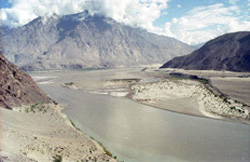The Hindu Kush-Himalayan region - River hydrology (1/3)
The Hindu Kush-Himalayan region is drained by 19 major rivers, of which Indus and Brahmaputra are the longest, each of which including mountain catchments of about 160,000kmē. The formation of mountains, the deepening of the valleys by the rivers, and self dynamic processes of rivers accompanied with regional characteristics of temperature and precipitation led to significant river systems and stream types.
 |
The Indus River at the Skardu Hills. The Himalaya is drained by 19 major rivers, of which the Indus (total stream length: 3,180 km), Ganga (total stream length: 2,071 km) and the Brahmaputra (total stream length: 2,580 km) are the most important. All three originate in Tibet. The principal rivers of the Indus system are snow-fed. Their discharge alters significantly during the year. Floods occur in the rainy season (July to September) due to the wet season of the monsoon and the snowmelt. Discharge is minimal during the winter. The Indus River flows from the high plateau of Tibet towards the lowland of Pakistan where it discharges into the Arabic Sea. It passes through three ecoregions (Subtropical Mountain, Subtropical Steppe, and Tropical Desert), increasing its catchment size tremendously. Thus the Indus River belongs to different stream types as ecoregion, altitude, and the catchment size select a stream type. |